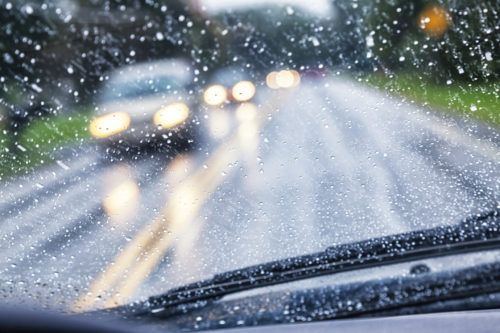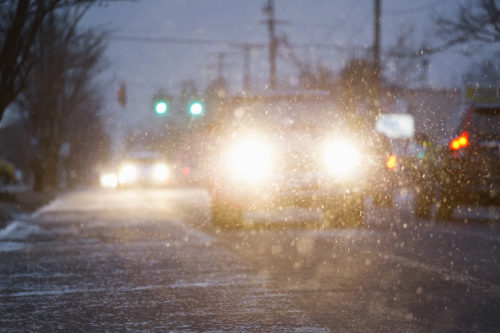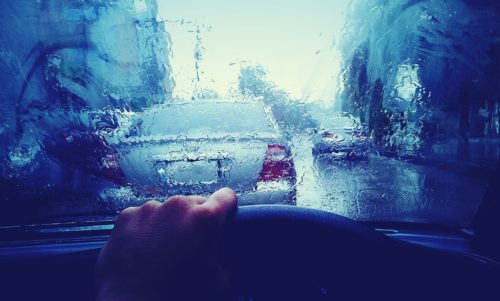Putting Safety First While Driving In The Rain
Most people have a love-hate relationship with the monsoon season. While it’s blissful to snuggle up indoors with a hot cup of coffee and watch the rain from your window, driving in a downpour can take the pleasure out of driving. Roads become wet and slippery, potholes and fallen trees pose dangerous hurdles, and mirrors become blurry.
For diving enthusiasts however, overcast skies, cool breeze and a light drizzle make for a perfect setting to take their cars out for a spin or long drive. It might not be the case this year as people prioritize health and avoid stepping out but if you must, make sure you are keeping safe by following these tips.
#1: Use Headlights When Dark

While driving through the rain during the day, you might not turn on your headlamps, assuming that the natural light is enough. However, heavy rain are often accompanied by dark clouds which can lead to a sudden loss of light, which might hamper visibility. So, to ensure safety, always keep your headlights on in low beam mode. It will also make other vehicles aware of your presence from a distance.
The auto headlamps in the Ford Figo light up the road automatically when they sense low visibility. This system is useful during rains where outside conditions switch between bright and dark.
#2: Say No to High Beam In The Rains

Most drivers switch to high beam while driving through the rain at night. You might think this is common as higher beams help you see the road ahead more clearly. But this may not be the best practice during rains because the light gets scattered due to raindrops, hampering the visibility of oncoming vehicles. Also, when the rain reflects bright light, it can create a sharp glare that might confuse other drivers and cause an unpleasant situation. To prevent this, keep the headlights at regular setting during rains.
Turning on the fog lamps in your Ford EcoSport is a good idea as it can increase visibility while you are driving. Additionally, you don’t have to worry about getting distracted by high beams from vehicles behind you since your EcoSport’s electrochromic auto-dimming rearview mirror automatically darkens at night. By reducing the intensity of light coming from vehicles behind you, this intelligent system helps make night drives safer.
#3: Stop During A Downpour

If you are stuck on the road when it’s raining, the first thing on your mind is to get home as soon as possible. You may think that waiting for the rain to cease would be a waste of time. So, you might decide to drive through a torrential downpour without realising the risks. Additionally, during heavy rain, the car’s wipers may have to work harder than usual to clear away the water and may even get damaged. A safe practice is to park your car at a safe spot and wait for the rain to subside.
#4: Get the ABS of Driving Right

No, we are not just talking about Anti-Lock Braking System, commonly known as ABS. The ABS of driving in the rain can keep harm away. Here’s what it means:
A – Always Alert: The thumb rule of driving in the rain is to always stay alert to changing road conditions. Rain swept roads often hide dangers from plain sight. For instance, seemingly harmless puddle can cover an open manhole and damage your car if you are not careful going over it.
B – Balanced Approach: Striking the right balance between Braking and Acceleration is critical to ensure complete control over your car. You should neither drive too fast nor brake suddenly as lower visibility, lack of traction compromises control.
Additionally, while cruise control is a convenient feature on open highways, it can be dangerous on wet roads as rainwater can bring substances like grease and oil on roads to rise to the top of the water, creating a slippery surface. And if your tyres cannot move through the water quickly, your car may skid while you apply brakes. In short, using cruise control during the rains could result in hydroplaning, even at low speeds.
S – Safety First: Driving in rain or not, safety has to be a top priority irrespective. It may be wise for you to pick a vehicle that comes with advanced technologies such as ABS, TCS and ESC.
An anti-lock braking system or ABS prevents your vehicle from skidding by ensuring that your car’s wheels aren’t locked during braking. This system is much more useful on slippery surfaces when tyres tend to lose traction and braking becomes extremely challenging. Infact, advanced ABS technology works with traction control system (TCS) and electronic stability control (ESC) to alter the distribution of brake between front and rear tyres, depending on their road grip. This helps the drivers to have complete control over their vehicle, even in difficult road conditions.
Ford EcoSport & Endeavour feature traction control and electronic stability control, which ensure better control and increased grip on the road surface, increasing the safety quotient on every drive.
#5: Maintain The Right Distance & Speed

It is advisable to drive at a low speed during the rains but slowing to a crawl can make things quite difficult for other motorists. So, ensure you drive in the correct lane if you wish to slow down. If you drive at a very low speed in the fast lane, motorists coming from behind might crash into you due to poor visibility or increased braking distance.
All Ford cars can ensure visibility at the road ahead thanks to their rain-sensing wipers that turn on automatically and adjust to the intensity of the rain. Additionally, rear wash wiper with the electric window defogger ensures you can see at traffic coming from behind you as well.
Driving during the rain is a hurdle; you need to be extra careful and pay close attention. And in the stress of reaching your destination on time, you might make a few mistakes, like the ones mentioned above. But even the smallest mistake might have the gravest consequences, so be mindful of your every move and drive safe.
Subscribe to our newsletter
Subscribe to our newsletter to stay upto date with latest news, offers and much more



